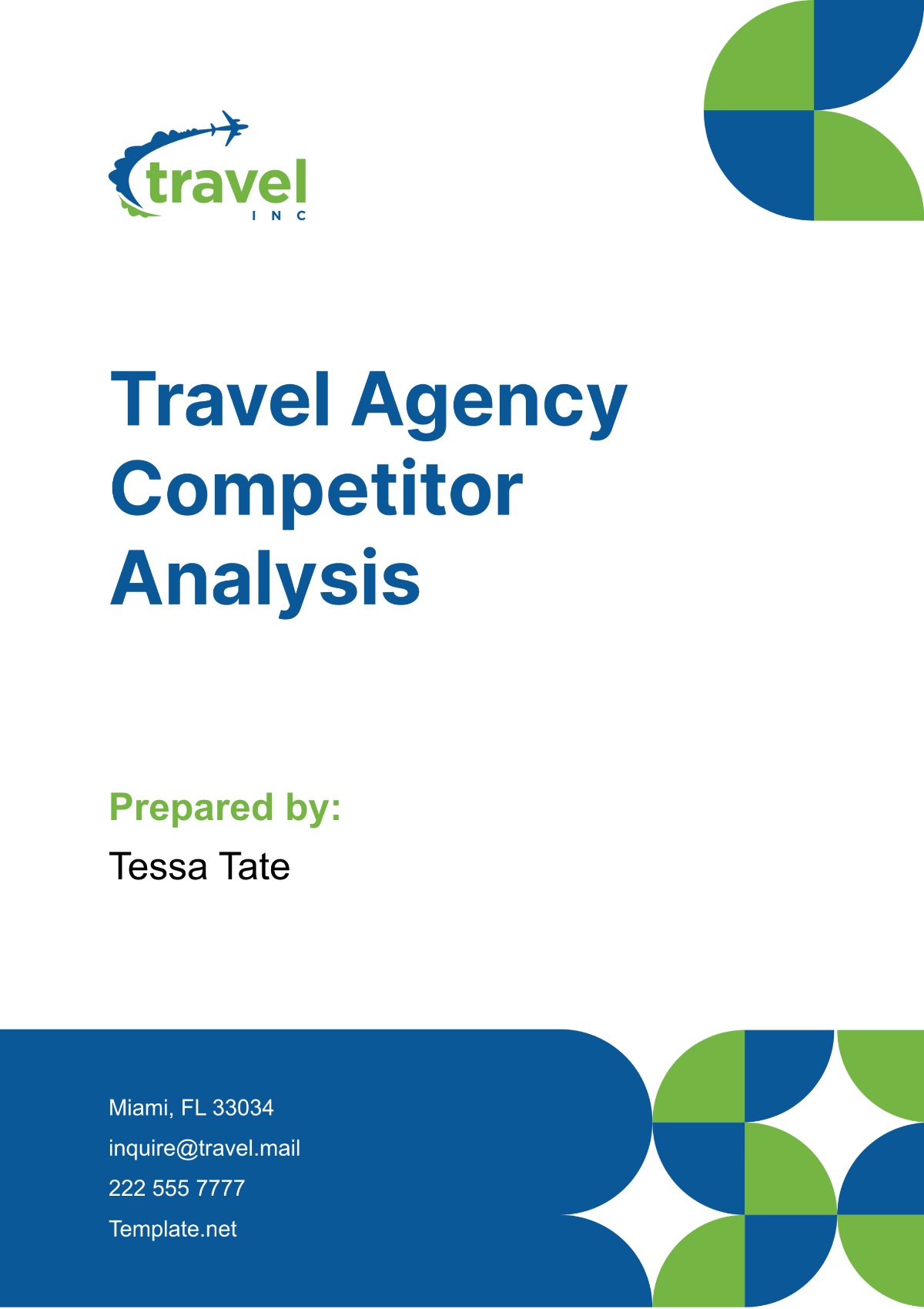Free Travel Agency Competitor Analysis

A. Executive Summary
Our comprehensive Travel Agency Competitor Analysis delves deep into the competitive landscape of the US travel industry, offering valuable insights and strategic recommendations for [Your Company Name]. Through meticulous research and analysis, we've identified key findings that shed light on the strengths, weaknesses, opportunities, and threats present in the market.
In this analysis, we've highlighted the competitive advantages of leading travel agencies, such as their market presence, unique service offerings, and branding strategies. Additionally, we've pinpointed areas where [Your Company Name] can leverage opportunities for growth and differentiation. By implementing the recommendations outlined in this report, [Your Company Name] can strengthen its position in the travel industry and enhance its ability to meet the evolving needs of travelers in the US market.
B. Company Profiles
In this section, we provide detailed profiles of key competitors shaping the landscape of the US travel industry. By examining the backgrounds, market presence, target audiences, services offered, and unique selling points of these competitors, we gain valuable insights into their strategies and positioning. Understanding the strengths and weaknesses of our competitors is essential for [Your Company Name] to refine its own offerings and stay competitive in the dynamic travel market.
Competitor A | Background: Founded in [2050], Competitor A has established itself as a prominent player in the US travel industry. With a focus on luxury travel experiences, they have built a reputation for delivering unparalleled service and exclusivity. Size: Competitor A operates a network of offices across major metropolitan areas and employs a team of experienced travel professionals. Market Share: Holding a significant market share in the luxury travel segment, Competitor A caters to high-net-worth individuals seeking bespoke travel experiences. Target Audience: Their target audience comprises affluent travelers who prioritize luxury, personalization, and exceptional service. Geographic Presence: While primarily focused on domestic clientele, Competitor A also serves international travelers seeking premium travel experiences. Services Offered: Competitor A offers a wide range of services, including personalized travel itineraries, exclusive access to luxury accommodations, private transportation, and concierge services. Unique Selling Points: Their unique selling points include curated travel experiences, partnerships with luxury brands, VIP treatment, and personalized attention to detail. |
Competitor B | Background: Competitor B emerged as a leading online travel agency (OTA) in [Year], disrupting the traditional travel booking landscape with its user-friendly platform and competitive pricing. Size: As one of the largest OTAs in the US, Competitor B boasts a vast network of partnerships with airlines, hotels, and tour operators. Market Share: Dominating the online travel booking market, Competitor B attracts budget-conscious travelers seeking convenience and value. Target Audience: Their target audience comprises a diverse demographic, including families, solo travelers, and business professionals. Geographic Presence: With a strong online presence, Competitor B serves customers nationwide and internationally, offering a wide range of travel options. Services Offered: Competitor B provides comprehensive travel services, including flight bookings, hotel reservations, vacation packages, car rentals, and activities. Unique Selling Points: Their user-friendly interface, extensive selection of travel options, price-match guarantee, and 24/7 customer support are key selling points that differentiate them in the market. |
C. Market Share Analysis
In this section, we delve into the market share dynamics of key competitors within the US travel industry, including [Your Company Name], over the span of three years (2052-2054). By examining market share percentages and trends over this period, we gain valuable insights into the competitive landscape. Utilizing a line chart to visualize this data enables stakeholders to discern shifts in market dynamics and empowers strategic decision-making to maintain and enhance our competitive positioning.
Over the three-year period from 2052 to 2054, Competitor B consistently maintained the highest market share, peaking at 45% in 2054. Competitor A experienced a gradual decline in market share, dropping from 35% in 2052 to 28% in 2054. Meanwhile, [Your Company Name] remained relatively stable, holding a consistent market share of around 10% throughout the period. These trends highlight the dominance of Competitor B and the need for strategic initiatives to compete effectively in the market.
D. SWOT Analysis
In this section, we conduct a SWOT analysis for each key competitor within the US travel industry, including [Your Company Name]. This analysis highlights the Strengths, Weaknesses, Opportunities, and Threats faced by each competitor, providing valuable insights for strategic decision-making.
Competitor A | |||
Strengths | Weaknesses | Opportunities | Threats |
|
|
|
|
Competitor B | |||
Strengths | Weaknesses | Opportunities | Threats |
|
|
|
|
[Your Company Name] | |||
Strengths | Weaknesses | Opportunities | Threats |
|
|
|
|
E. Product and Service Comparison
In this section, we conduct a comprehensive comparison of the products and services offered by key competitors in the US travel industry alongside [Your Company Name]. By evaluating factors such as pricing, quality, range of services, customer experience, and technological innovation, we aim to provide stakeholders with valuable insights into the competitive landscape. This comparison enables [Your Company Name] to identify areas of strength and opportunities for improvement in order to enhance its offerings and meet the evolving needs of travelers effectively.
Category | Competitor A | Competitor B | [Your Company Name] |
|---|---|---|---|
Pricing | Premium pricing model targeting high-net-worth individuals seeking luxury travel experiences. | Competitive pricing strategy with frequent discounts and price-match guarantees. | Flexible pricing options catering to diverse budget ranges, with occasional promotional offers for loyal customers. |
Quality | Exceptional quality of service, personalized itineraries, and exclusive access to luxury accommodations. | Consistent quality across a wide range of travel options, with a focus on reliability and customer satisfaction. | Commitment to delivering high-quality experiences with attention to detail and personalized customer service. |
Range of Services | Comprehensive range of luxury travel services, including customized itineraries, concierge services, and VIP experiences. | Extensive selection of travel options, including flights, hotels, vacation packages, and activities. | Diverse portfolio of travel services, spanning from budget-friendly packages to premium offerings for luxury travelers. |
Customer Experience | Emphasis on personalized service and attention to detail, with dedicated travel advisors providing tailored recommendations. | User-friendly platform with intuitive booking process and responsive customer support available 24/7. | Dedicated customer support team offering personalized assistance and proactive communication throughout the travel journey. |
Technological Innovation | Integration of advanced booking systems and digital platforms for seamless reservations and itinerary management. | Utilization of cutting-edge technologies for data analytics, dynamic pricing, and personalized recommendations. | Adoption of innovative solutions to enhance the booking experience, including AI-driven chatbots and mobile app functionalities. |
F. Marketing and Branding Analysis
In this section, we analyze the marketing strategies and branding efforts of key competitors in the US travel industry, including [Your Company Name]. By examining advertising channels, promotional tactics, social media presence, customer engagement strategies, and brand positioning, we gain insights into competitive positioning. Visualizing this data provides stakeholders with a clear understanding of competitors' marketing tactics and enables [Your Company Name] to refine its own strategies effectively.
Competitor A and Competitor B employ different promotional tactics to attract customers. Competitor A focuses primarily on offering discounts, comprising 40% of its promotional strategy, while Competitor B allocates a larger portion to loyalty programs, accounting for 30%. However, Competitor A also dedicates a significant portion to loyalty programs at 25%, indicating a balanced approach. In contrast, [Your Company Name] emphasizes loyalty programs the most at 35%, aligning with its strategy to cultivate customer loyalty.
G. Future Outlook and Recommendations
In this concluding section, we offer insights into emerging trends and developments within the travel industry, along with strategic recommendations for [Your Company Name]. With the travel landscape constantly evolving, it's essential to anticipate future challenges and opportunities to maintain a competitive edge.
Future Trends
Continued growth of sustainable travel and eco-tourism.
Increasing demand for personalized and immersive travel experiences.
Integration of advanced technologies such as AI, virtual reality, and blockchain in travel services.
Shift towards remote work and digital nomadism, leading to flexible travel arrangements.
Recommendations
Enhance Personalization: Invest in technology to personalize travel experiences based on individual preferences and behavior.
Expand Sustainability Efforts: Introduce eco-friendly initiatives and promote sustainable travel practices to appeal to environmentally conscious travelers.
Strengthen Online Presence: Improve website functionality and user experience to facilitate seamless online bookings and engagement.
Diversify Offerings: Explore new travel segments or niche markets to broaden the customer base and mitigate risks associated with market fluctuations.
Foster Partnerships: Collaborate with local businesses, tourism boards, and influencers to create unique travel experiences and enhance brand visibility.
In conclusion, this Travel Agency Competitor Analysis offers a comprehensive understanding of the competitive landscape within the US travel industry. By examining the strengths, weaknesses, opportunities, and threats of key competitors alongside strategic recommendations, [Your Company Name] is equipped to navigate the evolving market dynamics successfully. As we embark on the journey ahead, embracing innovation, enhancing customer experiences, and staying attuned to emerging trends will be pivotal in solidifying our position as a leader in the travel sector.
- 100% Customizable, free editor
- Access 1 Million+ Templates, photo’s & graphics
- Download or share as a template
- Click and replace photos, graphics, text, backgrounds
- Resize, crop, AI write & more
- Access advanced editor
Uncover strategic insights with Template.net's Travel Agency Competitor Analysis Template. This editable and customizable document simplifies the process of analyzing competitors in the travel industry. Tailored for travel agencies, it provides a comprehensive framework for identifying strengths, weaknesses, and opportunities. Editable in our Ai Editor Tool, it enables seamless customization to meet your specific needs.





























